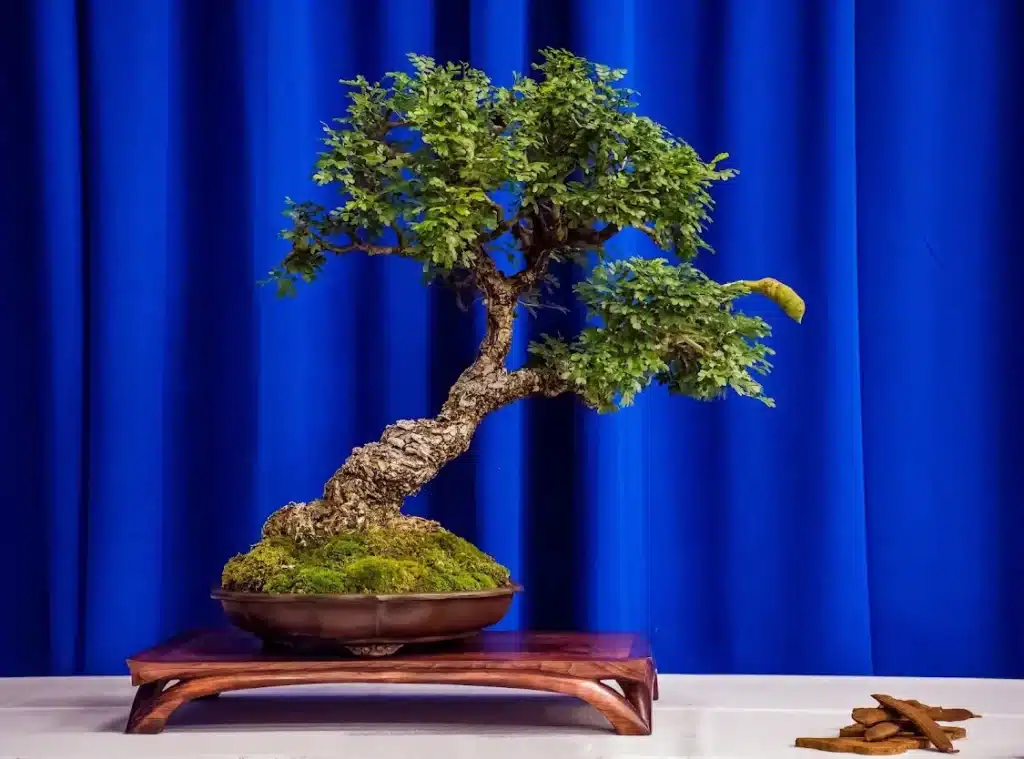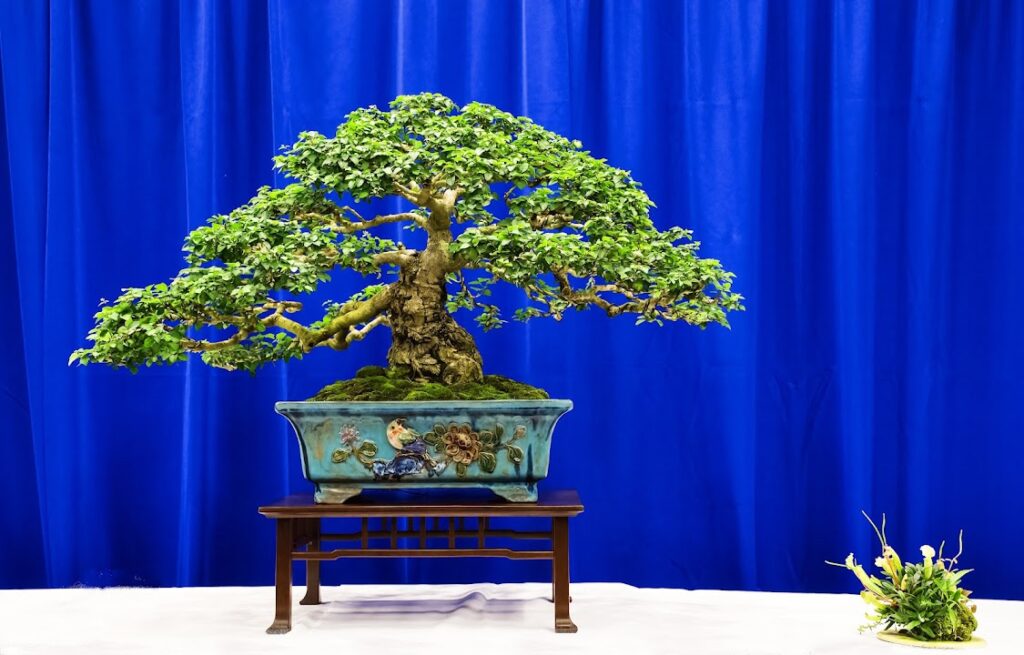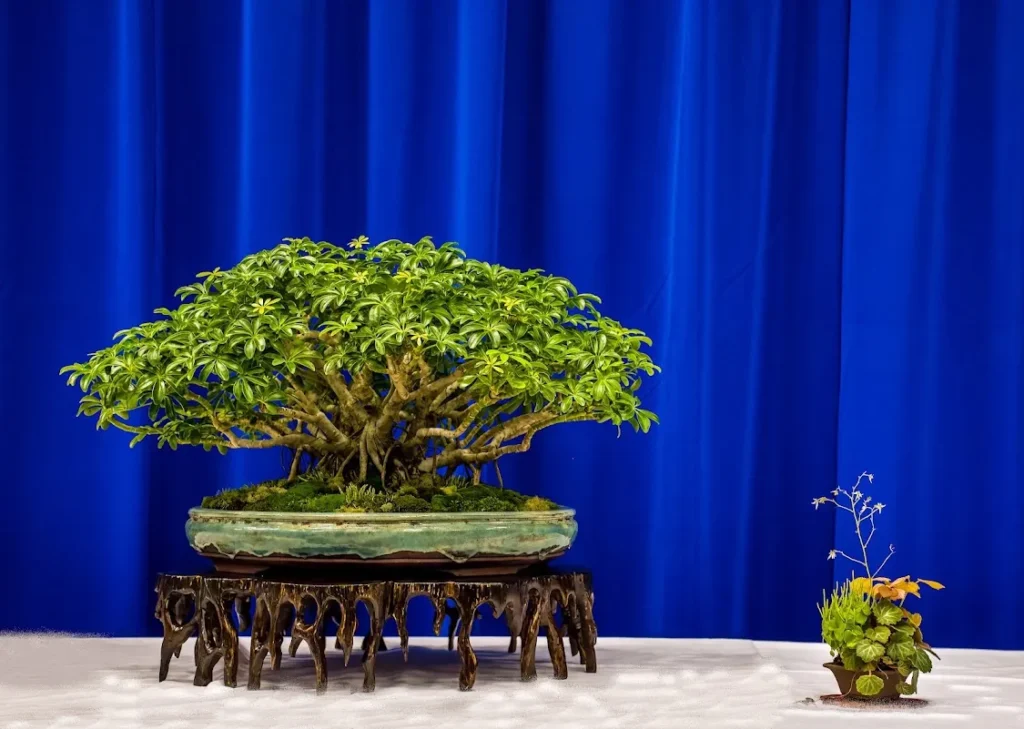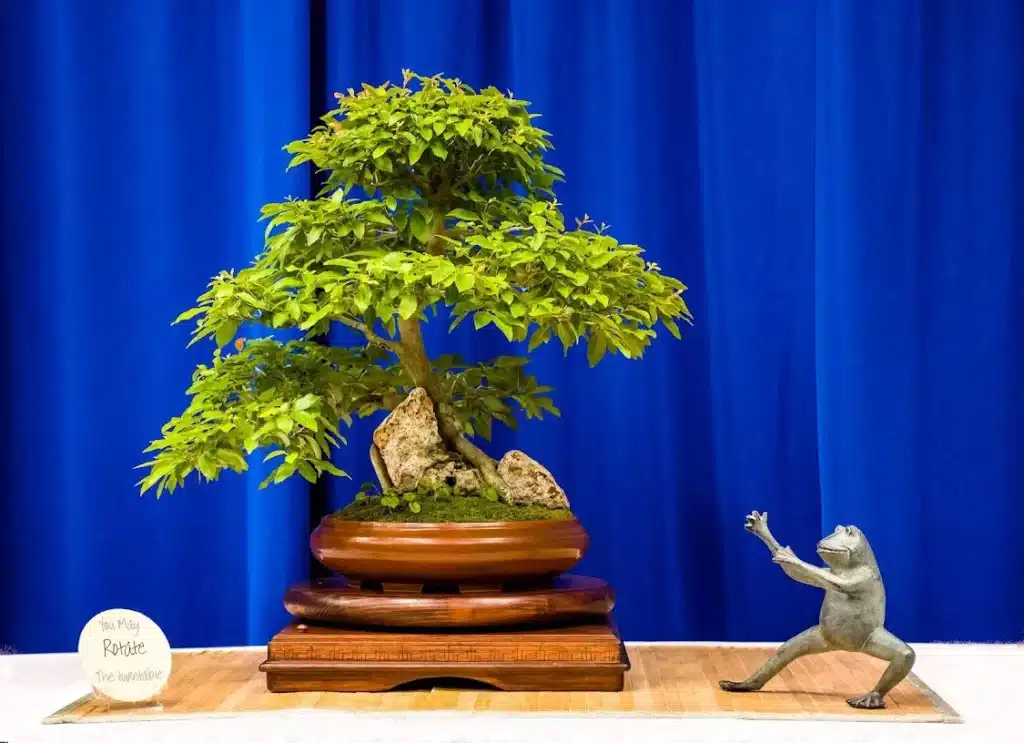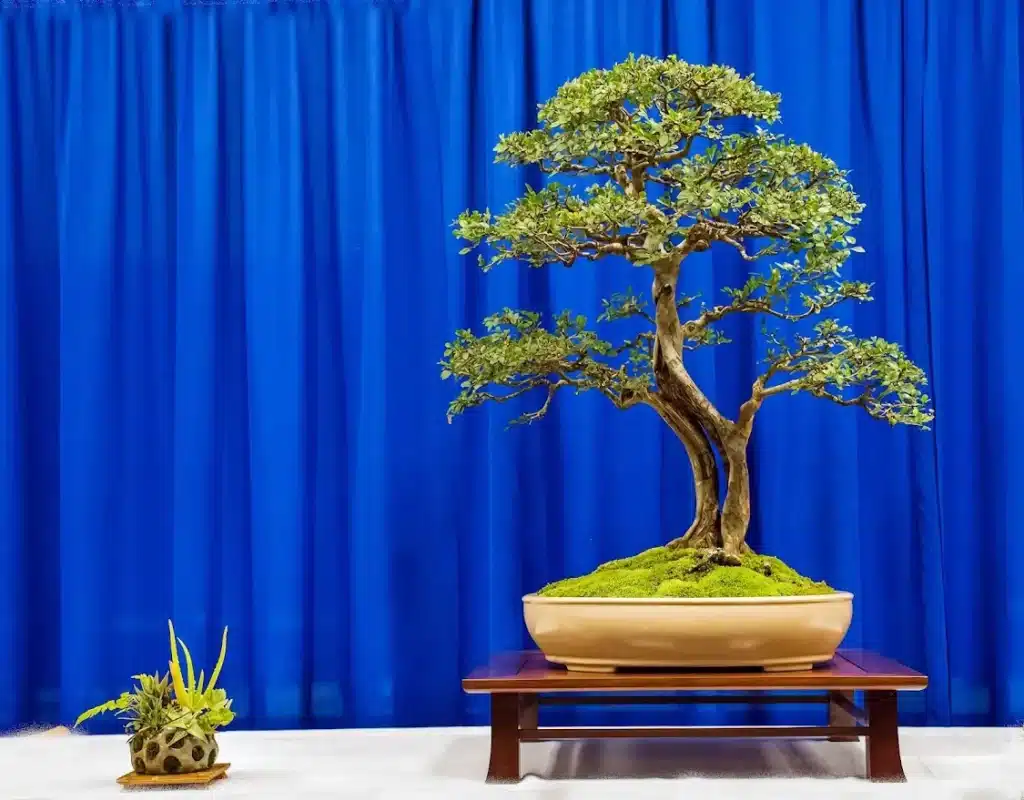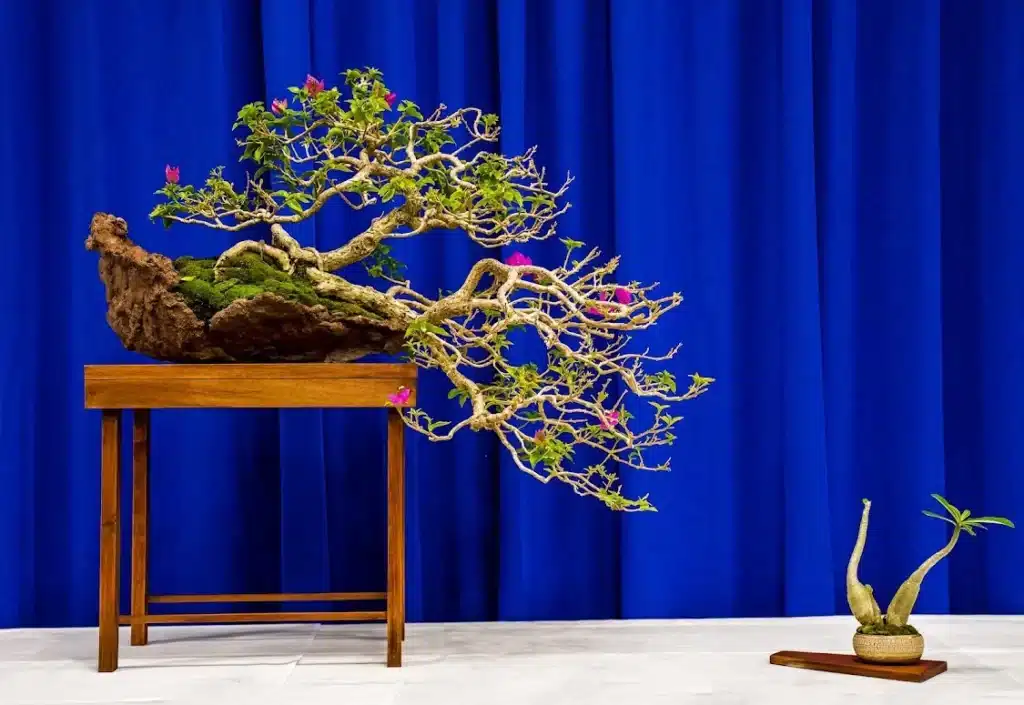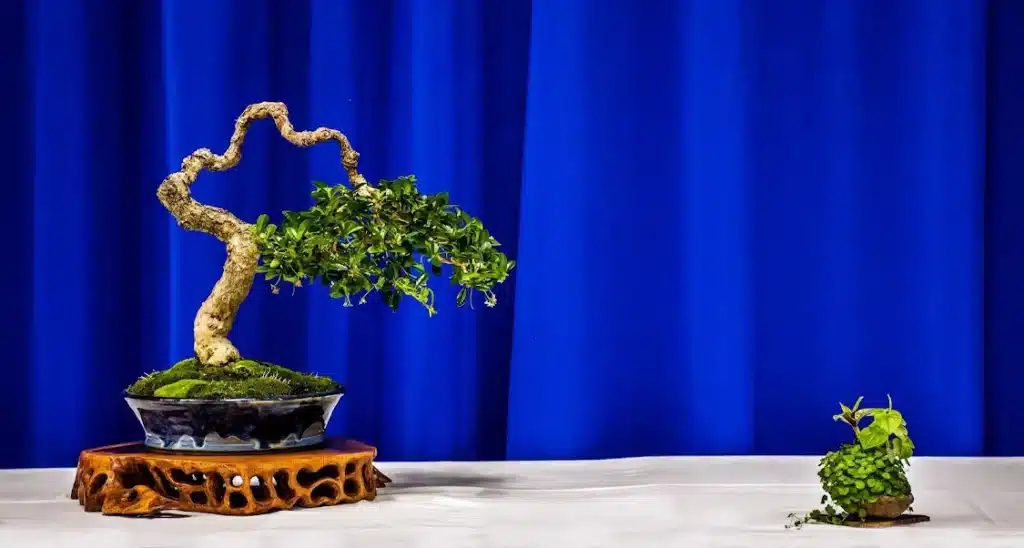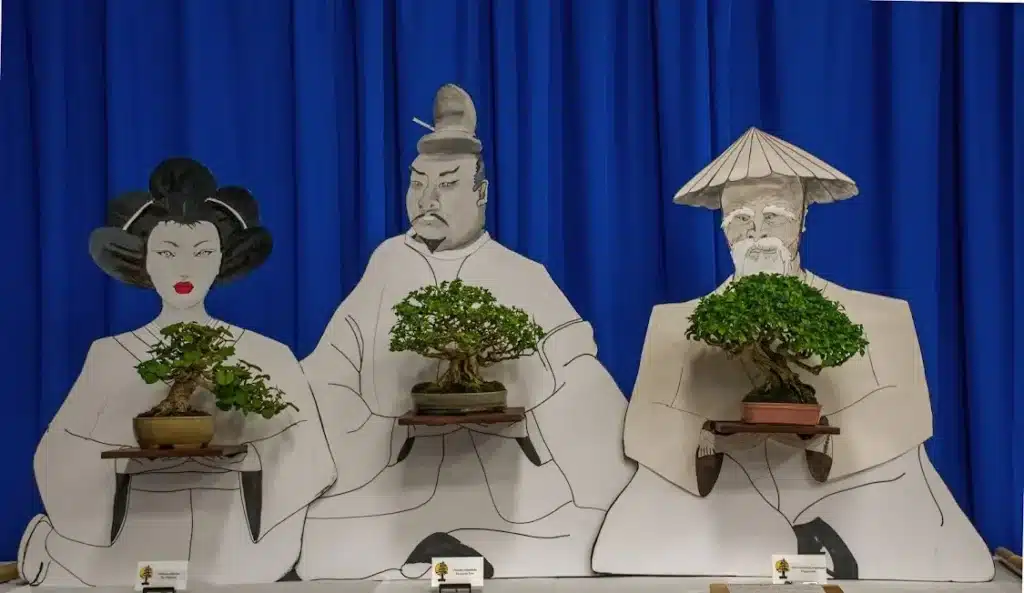The Florida Bonsai Magazine: Summer 2022
President’s Message
By Kathrin Harris
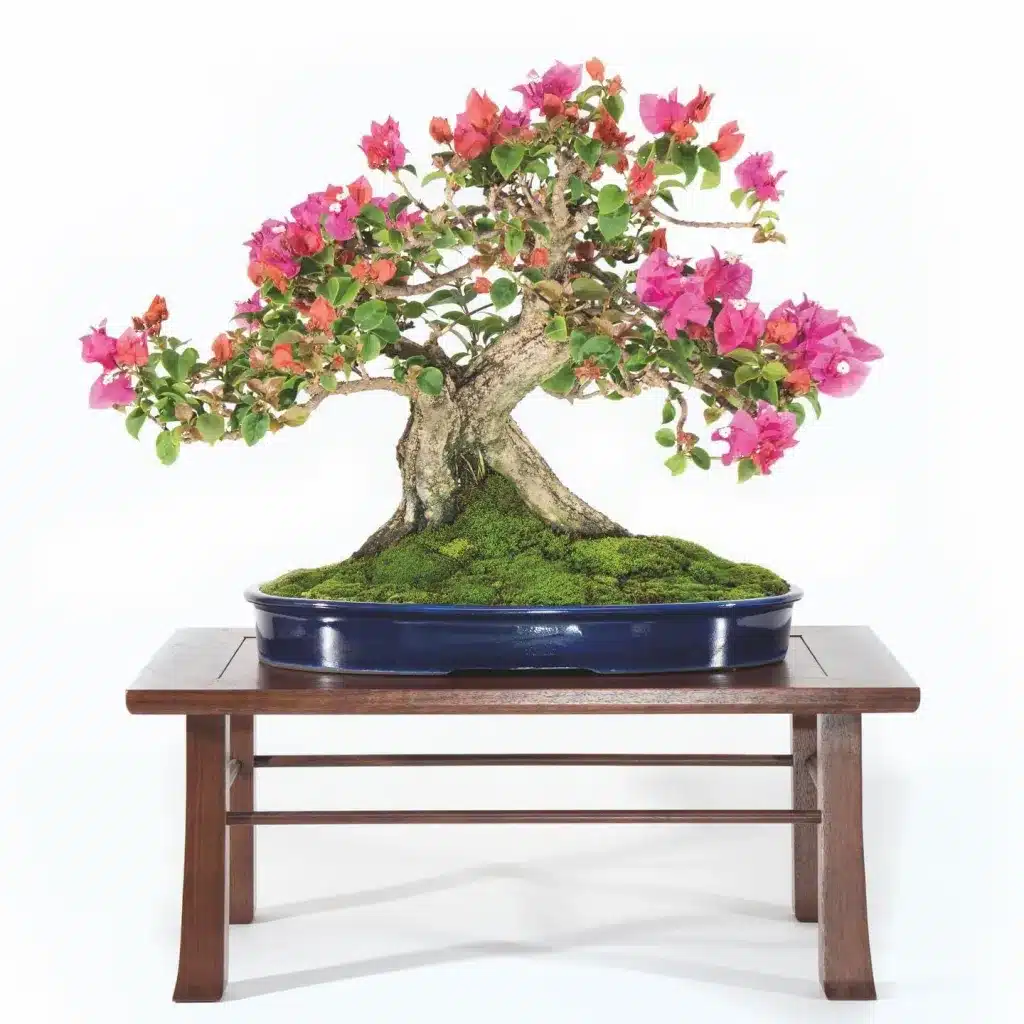
If you read the Spring edition of the BSF Magazine, or attended the very successful 2022 convention, you know that congratulations are in order for Jorge’s career advancement! Sadly, this meant he had to move to North Carolina and resign as BSF President, yet fortunately, Jorge is still involved, and can now be reached at convention@bonsai-bsf.com. As his successor, I have large shoes to fill—Jorge was a very effective, go-getter President, and I thank him for leaving the group well organized and ready to take on new initiatives or challenges. A brief introduction of me:
My friend Kay Karioth (served for years as Trustee of District 7) got me involved in bonsai in 2008. Adam Lavigne happened to be guest artist that first evening at the Sho Fu meeting in Sarasota, and I was the lucky winner of the ilex he worked on (I even had to borrow the one dollar for the lone ticket I bought)! Everyone figured this newbie would kill that poor tree, but I heeded the advice to just leave it be for a year and keep it alive before trying to wedge it into a bonsai pot, and I have the tree to this day. I have served on the Sho Fu Board for 11 years, most recently as treasurer and membership chair for nearly seven years now.
Jorge asked me to serve as BSF 1st VP three years ago, and, while I was reluctant due to my family commitments, he really did not task me with too much. I enjoyed my role as Membership liaison between BSF and the member clubs, and now I look forward to serving in my new role as your President. I ask that you all be patient with me while I learn the complexities of this state-wide charitable organization, and anticipate that you will feel free to come to me with both ideas and gripes.
Back to the convention:
➢ The exhibit was beautifully coordinated by Chairs Christopher and Jeanne Cosenza. The trees were all in great condition, their mossing looked fabulous, the displays artfully arranged, and the overall exhibit gave viewers an appreciation for the amazing variety of trees our great state supports horticulturally.
➢ The workshops were sold out and offered great material.
➢ The scholarship competition had 8 participants from all around Florida that gave observers much to appreciate.
➢ The Florida Collective Event featured David Cutchin and five of his apprentices working on four different trees thriving in the four different Florida climate zones. This four-hour long event was recorded by Mirai Bonsai and will soon be available to BSF members for viewing.
➢ Club Night had 7 participating clubs that each chose to work on material centered around the convention’s theme of forests. Although I was unable to participate with my home club, I’m proud to say that Sho Fu won first place, and its buttonwood arrangement brought in the most money at that evening’s auction for BSF.
➢ The Sunday evening banquet again had a special place setting for the Fallen Soldier, commemorating the purpose of Memorial Day weekend. I had hoped to bid farewell to Jorge myself, but I spent the day at the ER with my mother, Adam graciously read the speech I had prepared.
On Friday morning of every convention, the Board meets for its semi-annual meeting. A discussion topic was the BSF Governing Documents: the Bylaws, requiring member approval for revisions, and Guidelines & Procedures, requiring Board approval for revision. In January, Jorge appointed a task force to review these documents and propose changes, additions/deletions. The resulting proposals were circulated via email to the full Board early May for consideration, and approved at the May meeting. The Bylaws were then circulated to all club presidents for feedback and approval. The changes were unanimously accepted by clubs, and can be viewed on the BSF website by going here: https://bonsai-bsf.com/about-2/bsf-by-laws/
Another area of discussion that arose during the May Board meeting was the notion of a dues increase. For over 15 years, the minimal $15 annual dues payable to BSF for each member of a BSF affiliated society has been unchanged. BSF is dedicated to exposing and educating people on the beautiful art of bonsai, which is accomplished mainly during the annual convention. Due to the recent spike in cost increases for everything from insurance and storage, to hotel charges, artist fees, and materials needed for the convention, the Board asked the Finance Committee (made up of Treasurer, President, Past President, and 2nd VP) to come up with a recommendation regarding dues. The committee has voted to recommend the Board approve a dues increase to $20 annually at its January 2023 Board meeting. If the Board approves this recommendation by majority vote, the new amount would only take effect in 2024.
How do those BSF dues benefit the clubs and their members? Here’s a brief list:
• liability insurance for club events,
• free advertising of club events on BSF website,
• extremely informative digital magazine,
• reduced registration fee for annual convention,
• ability to submit trees for exhibition at Epcot and/or the annual convention,
• ability to join in club night and scholarship competitions which pay out cash awards for winners,
• visiting artist program (once both artists and clubs are ready for this in these post-Covid times).
While the $5 is a 33% increase, had one subjected the $15 to CPI increases since 2007, this figure would actually be closer to $23 today. You may not be aware that BSF must pay for insurance, equipment storage, bank fees, convention material care, and many other expenses that arise from time to time. Without a dues increase for 2023, BSF must act upon our treasurer’s annual plea to seek donations to make up for a potential shortfall in income over expenses. I wish to thank several nurseries and individuals for generous donations of plant material in the past—this helps offset the cost of workshop or demo materials, or increase raffle intake, during the convention. Please consider donating cash, plant or bonsai-related material for use in future conventions. Of course your donations are tax deductible, and if wanted, BSF will issue a donation receipt. Our website’s home page makes cash donations simple: just go to https://bonsai-bsf.com/ and click on the large red Donate Now button towards the bottom of the front page. We accept PayPal or credit cards, and you may select whether to benefit the Scholarship Fund or the Convention Reserve.
Please take advantage of our informative Website. In it you will find upcoming club events, BSF magazine editions, and Donate Now on the home page; educational information https://bonsai-bsf.com/education/; a listing of all clubs and meeting times; links to various vendors, blogs, and organizations; photos of Epcot Exhibits dating back to 2007; information about prior conventions, and, now active, the ability to upload artist information for anyone who has a special interest or gift to share their knowledge about various aspects of bonsai (Click here). This database will be available to all clubs, individual BSF members and, really, anyone. It is a database designed to let everyone the world over realize the talent, education, and artistry that Florida Bonsai has to share.
Do not forget to send us your flyers for club-level events such as exhibits, workshops, auctions etc. (email to website@bonsai-bsf.com) so that we may post them. If we don’t know about it, we can’t promote it.
I wish you all a wonderful fall season and hope you have lots of time to spend with your trees!
Warm Regards, — Kathrin Harris, BSF President
First time at Epcot
By Angelica Ramirez
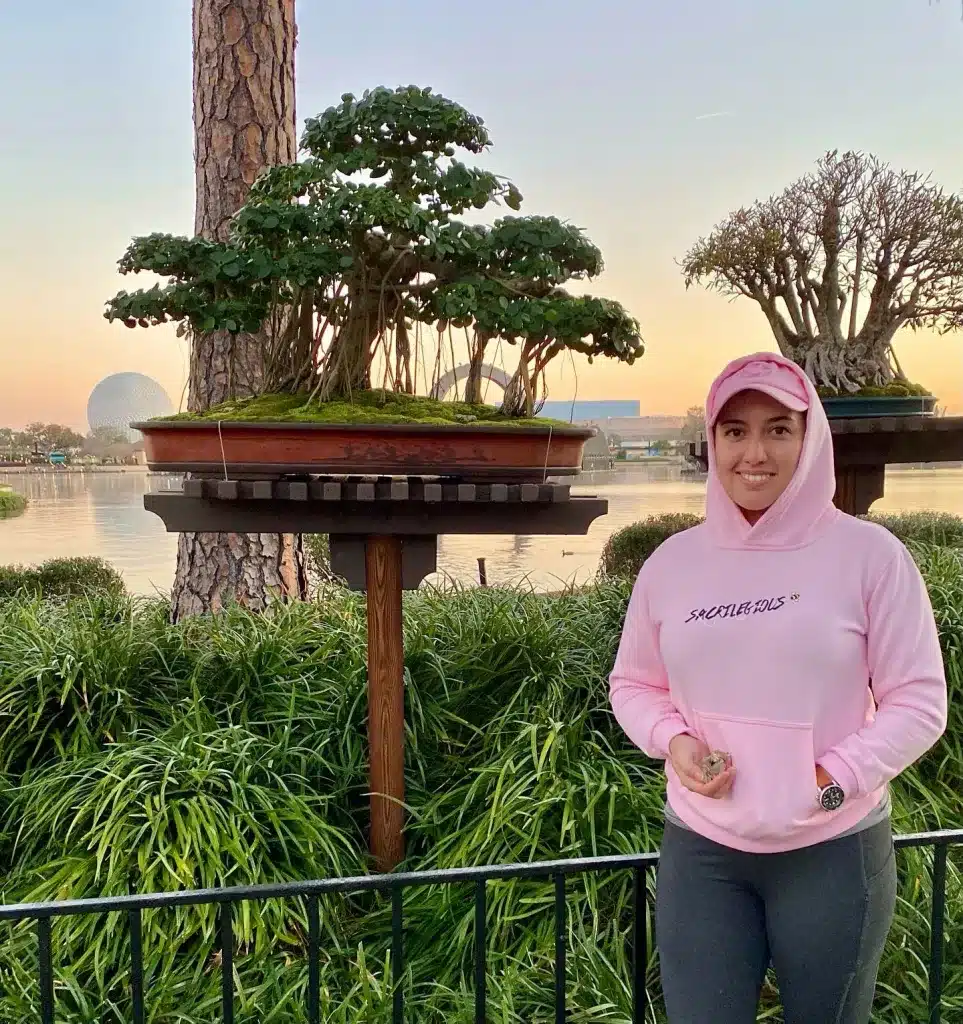
My Epcot experience started on the morning of March 1st 2022, the day before setup. Loading the tree into the van was the first challenge. It took three people to lift the heavy tree. Later that afternoon my father and I headed to Disney’s Coronado Springs Resort & Gran Destino Tower, where we were scheduled for a meeting with everyone involved in this event. I saw some familiar faces and met several new people. We discussed the plan for setup the next morning and grabbed a late dinner after. By the time we finished with dinner, it was close to midnight and we had to be up before 4am! Managed to get in a few hours of sleep before we had to meet everyone in the lobby and make our way to Epcot’s backstage area. At 4am, Epcot’s backstage was alive! It was bustling with hundreds of people working to make Epcot’s visitor experience magical! Little by little, small groups of the exhibitors were escorted to the Japanese Pavilion. It felt surreal to drive inside Epcot. The entire area was lit up by big portable construction lights. One by one, each tree was placed and secured onto their stands. You could feel the excitement. Each time a tree was placed, all of us crowded around to admire it. Three Epcot employees were able to lift my tree up out of the van and onto its stand. I was so nervous watching, praying they wouldn’t drop it, but I couldn’t look away. My tree was placed in between Josh Brown’s flowering Loropetalum (left) and Reggie Perdue’s willow leaf ficus (right).
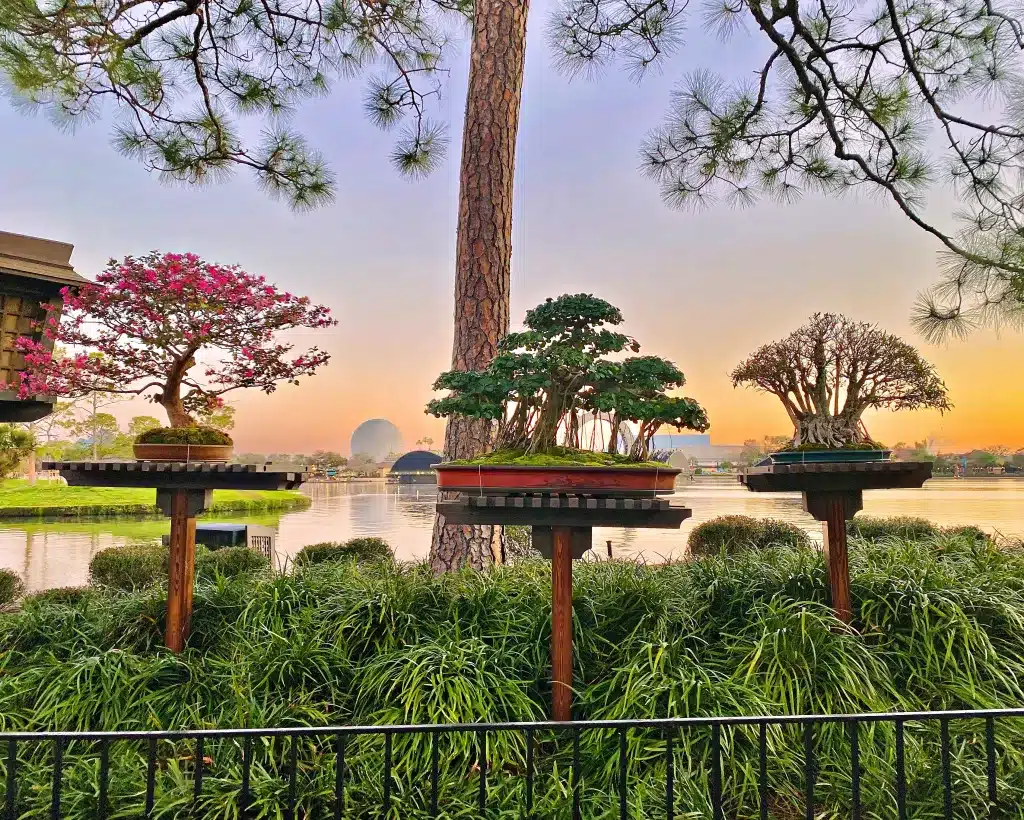
What a beautiful sight! Better than I could have ever expected. By the time all the trees were set up on their displays, the sun was starting to rise. It was a cold early morning and I was exhausted, but seeing the sunrise behind my tree with Epcot’s signature sphere in the background was completely worth it. As we walked away back toward our van to leave, I took one last look at my tree.
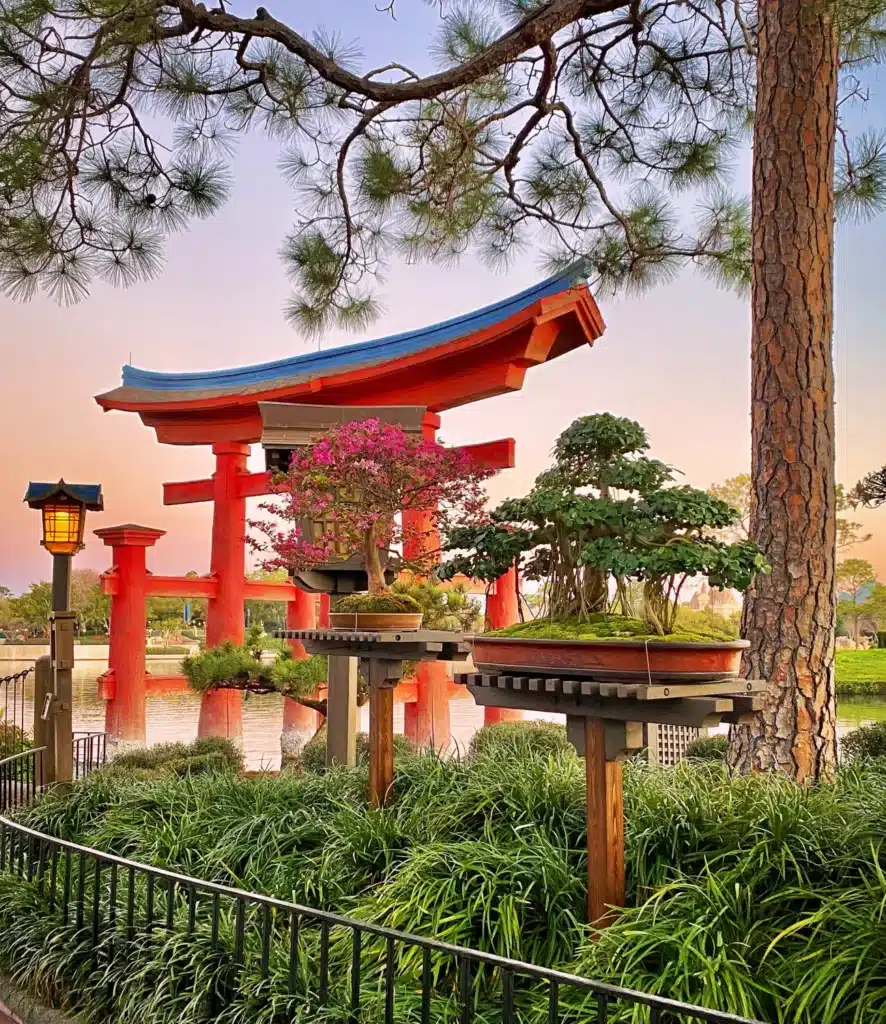
So what happens to the trees during the four months on display? Everyday, trained Epcot staff water the trees. Every Saturday morning, each exhibitor takes a turn visiting. The trees are checked to make sure they are being watered correctly, that there are no problems with pests or diseases, removing any weeds, and lightly trimming for shape. If there are any problems, the owner is notified. The owner can also contact the person that will be visiting the next weekend to give them instructions on what they would like done to their tree. After each visit, an email is sent out to everyone with details of how each tree is doing and what was done during their visit. Most times pictures are also available to see the trees.
On May 17th I visited Epcot with the family to see how my tree was doing. It was definitely in need of a hard prune but it still looked good nonetheless. It was a beautiful deep green and the tree looked healthy. I was so happy to see it! I had a fun time talking to several park guests about the trees. For lunch we ate at the second floor Japanese restaurant and were seated at a window table with a direct view of my tree! Afterwards, we walked around the park multiple times, always stopping in front of the trees for a break. We stayed until the park closed to watch the fireworks show and I had an idea for a cool photo. I wanted to capture the fireworks in the background of my tree. It was dark so I wasn’t sure if it would work but I was lucky! This was an emotional experience for me, I never imagined I’d one day have my bonsai on display at Epcot. Standing by my tree while watching the fireworks show had me tearing up. A truly magical experience.
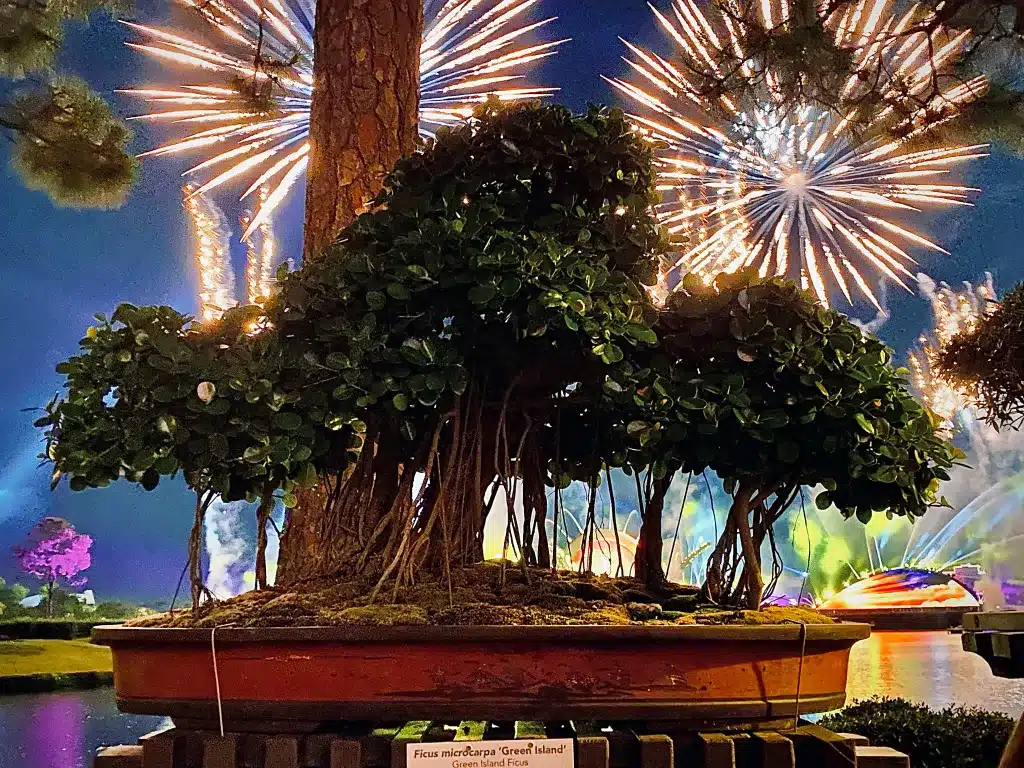
A big thank you to Paul Pikel and the Bonsai Societies of Florida for putting on a well managed, fantastic display!
Epcot Exhibit Video
By Jorge Nazario
Jorge Nazario has put together an amazing video of the BSF Exhibit from this years Epcot International Flower and Garden Festival which ran from March-July 2022
Click on This link to watch
Breaking Good
by Jack Yost
Over the years, as we mature in bonsai, one tool leads to another, gifts come, bargains are to be had at auctions, new tools come on the scene, and new tool makers. The end result is that we have a lot of tools, we get proficient at using them and often enjoy it. The right tool in the right place, nice and sharp. A satisfying click and that’s a minor reward from the tree.
However… A well-known left coast bonsai expert and ex-fireman, Dan Robinson, pushed the notion that bonsai trees should not have “bullet holes”. If you would like a natural look for the tree you are working on, consider breaking branches off rather than cutting them. It’s the flush cuts or concave cuts that create bullet holes.
Sometimes you don’t want jin, you don’t like the branch in that spot alive or dead, long or short. A scar on the other hand can be a good thing. If it looks natural, it can be a feature not a flaw.
One way to approach this is to consider using leverage to basically pull the branch out of a “socket”. For branches up to ¼” you should be able to use jin pliers or needle nose pliers.

Grab the branch tightly with the pliers and twist to roll the branch down pivoting over the tool and out of the trunk!
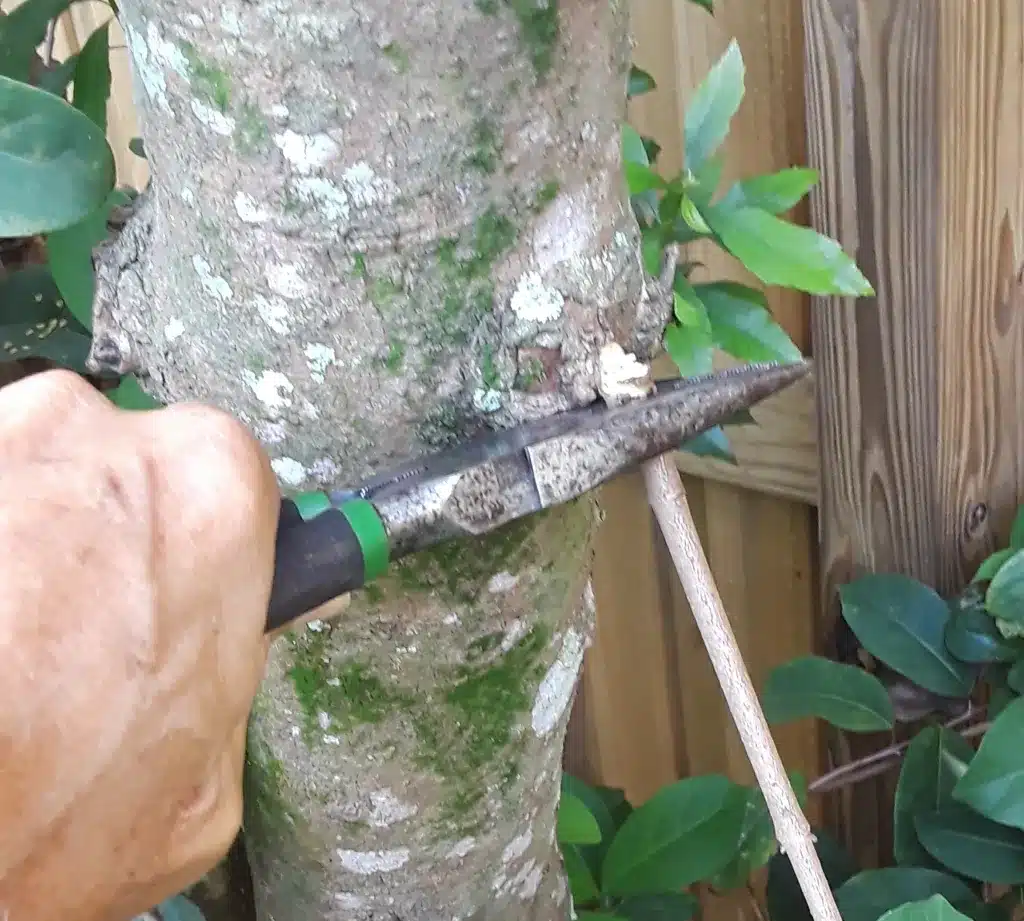
For bigger branches try using slip joint/Channel lock piers. Let a bit of bark get stripped down in the process but cut the tail off as needed to stop a long tear scar.
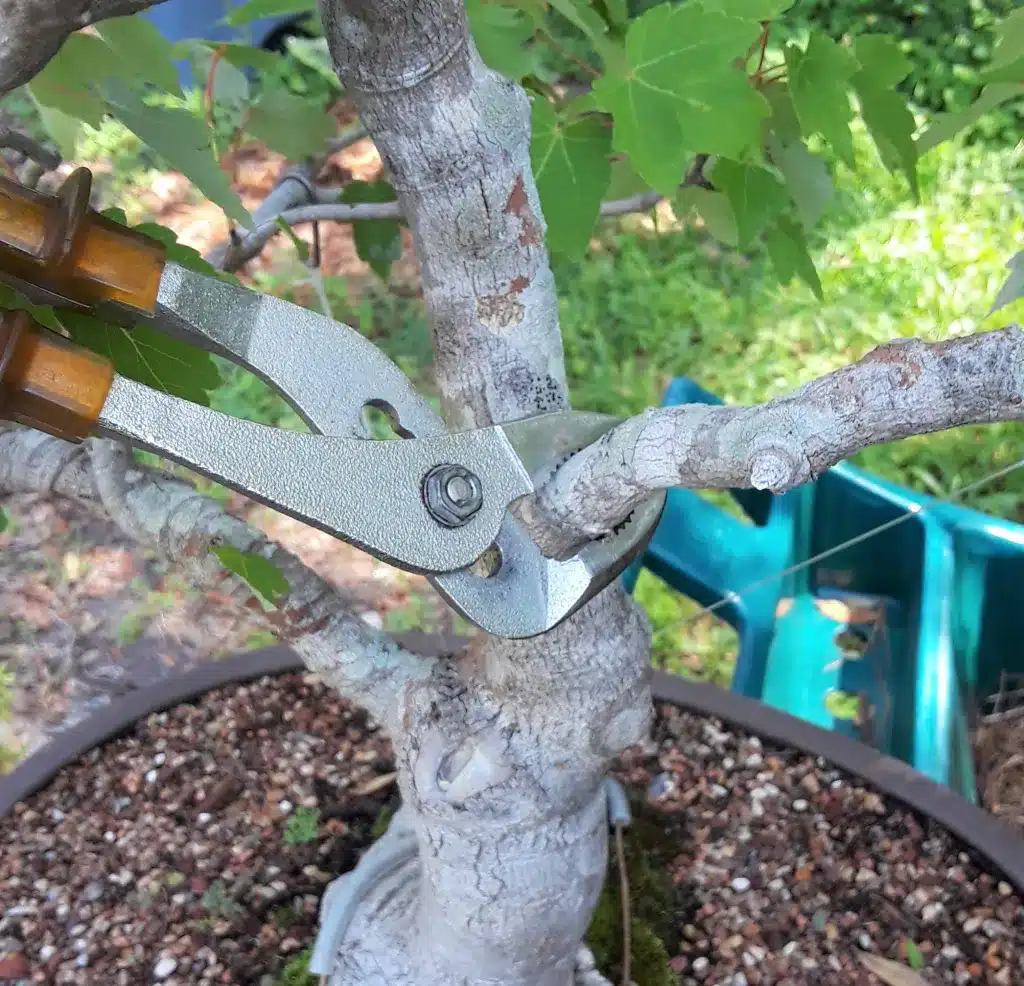
This will work better on some species than others. Bald cypress is good and so is Florida privet. Don’t worry if it does not work perfectly, you can always clean it up as needed with no harm done. Pines for example don’t respond as well as we would like unless you want a ragged short stump. This is because pines are so flexible and not prone to clean breaks; generally a good thing in bonsai.
When it does work well, it leaves a hole that is better than a cut made by any tool.
You can also bind the wound with raffia or tape to direct the new growth into the hole and thereby reduce the ‘horse collar’ raised edge scar that many wounds get on healing.
If you are not already breaking branches on purpose give it a try and try it on a variety of species and different size branches.
Maybe this will be a new tool for your mental toolbox.
Florida Artist Database
The form is now active on the BSF website to sign up your name to be included in an initiative to create a database of all the talented individuals in the state who are willing to share their talents with the bonsai world. It is free to sign up and use.
Do you make bonsai display tables and want to show how you make them? Are you an expert in pest control? Fertilization? Propagation? Can you give a talk on shohin trees or the care of junipers? Tool maintenance, deadwood carving, wiring, soil composition, just about anything bonsai related is acceptable. We just need your name, contact info, and willingness to travel and how far, and your area of expertise, and we will populate the database.
Simply go Here and fill out the form. But we can’t do it without you. We ask club presidents, the district trustees, and those who know others who’d be willing to teach and share their knowledge to get the word out.
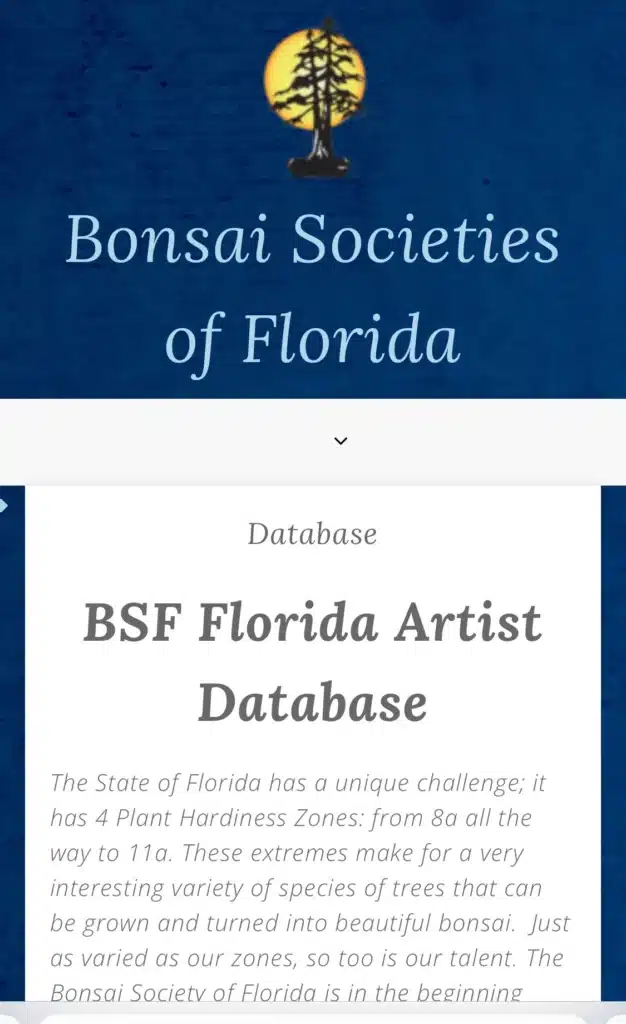
Tribute to Jorge
By Adam Lavigne
Jorge and I, in pursuit of bonsai knowledge and conducting BSF business, sometimes seemed like we were connected at the hip. We went everywhere from nurseries, to garden exhibits, private collections and, of course, various eating establishments.
Please enjoy this photo montage created by my iPhone.
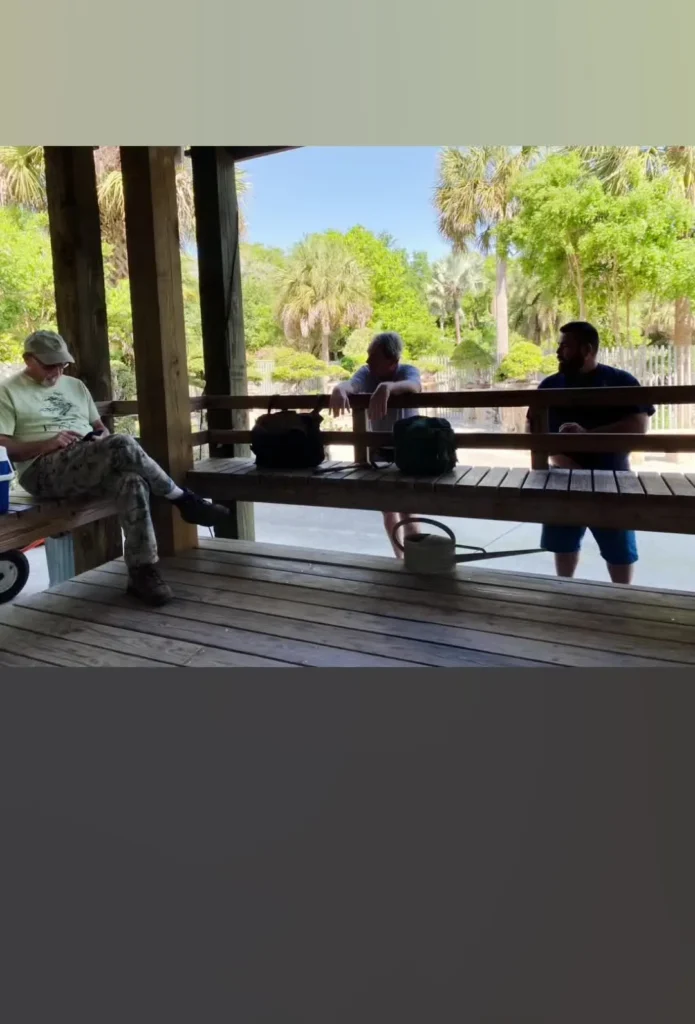
A Tamarind Tree Grows in Tampa
By Shaji Mathews
Every bonsai tree has a story. That’s what makes them so special.
Once upon a time, there was a tamarind tree (Tamarindus indica) that grew in my parent’s backyard in India. It was about 20 feet tall and 2 feet in diameter at the base. The tree had beautiful bark and gnarly branches. In season, the tree would be loaded with pods that we collected for cooking.
Ever since I got interested in bonsai, I wanted to try creating a tamarind bonsai that would look like the tree we had in India. Around ten years ago, I got seeds from my hometown that I planted in pots. Out of ten seeds, seven sprouted without any effort other than soaking in water overnight before planting. I was living in Michigan then and when summer turned to the long Michigan winter, the pots had to be moved indoors. Six out of the seven seedlings died after one season indoors. But one survived despite four months outdoors and eight months indoors for about five years.
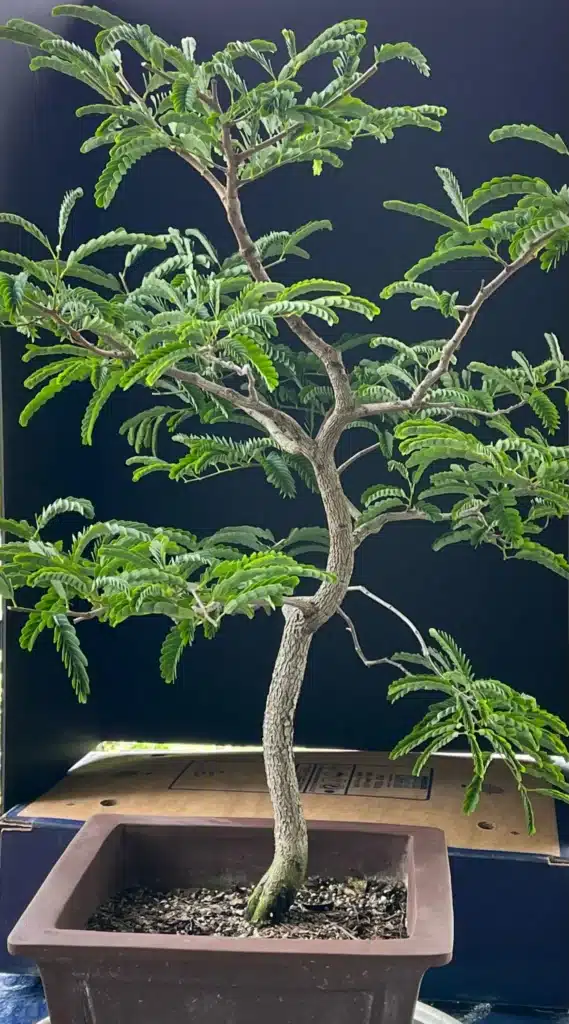
It was one of the few plants that I moved with me to Florida. At last, tamarind found the weather suited to it in Tampa!
After seeing many tamarind bonsai trees from others in the club and at bonsai displays, I realized the mistake of trying to call a plant a “bonsai” when it is really not a “tree in a pot” but a sapling. The plant is now back in a grow pot to let it grow. Lesson learned: you can’t rush a bonsai!
That should have been the end of this story. But a year ago, I came up on a couple of plants which were going to be bulldozed for road construction. I dug them out and put them in grow pots as well. A google search told me that those plants are called “river tamarind”. Scientific name is Leucaena leucocephala. Another Tamarind for me!
In their natural form, they tend to grow without very defined shape. My collected plants were the same way, trunk with no movement. And they were past inducing any movement by wiring. I decided to try the wedge technique I saw online and YouTube videos on one of the plants. Essentially this involved removing a wedge of material from the trunk and bending the tree to the angle you want. While the bend I created wasn’t as smooth as the videos have shown, at least the trunk now has some movement.
I am attempting to train the second tree with the straight trunk in the African style (Pierneef) with a flat top.
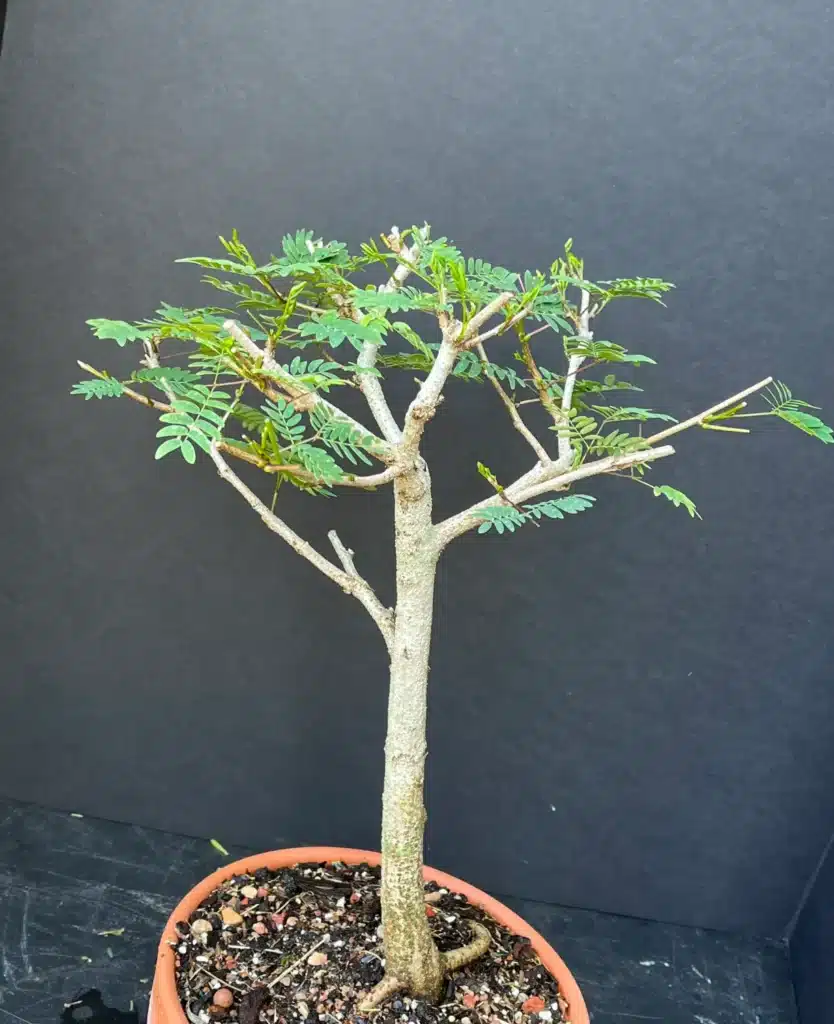
A street in my neighborhood in Tampa is named “Wild Tamarind” which I assumed was a made-up name until I recently found a “wild tamarind” tree in a native plant nursery. It has very attractive leaves and a reddish stem. Since it was not trained for bonsai, the tree is about 3 ft tall with a straight trunk. My intent is to air layer the top and see if that or the base could be developed into a bonsai tree. This will be the third variety of tamarind for me. Scientific name is Lysiloma latisiliquum.
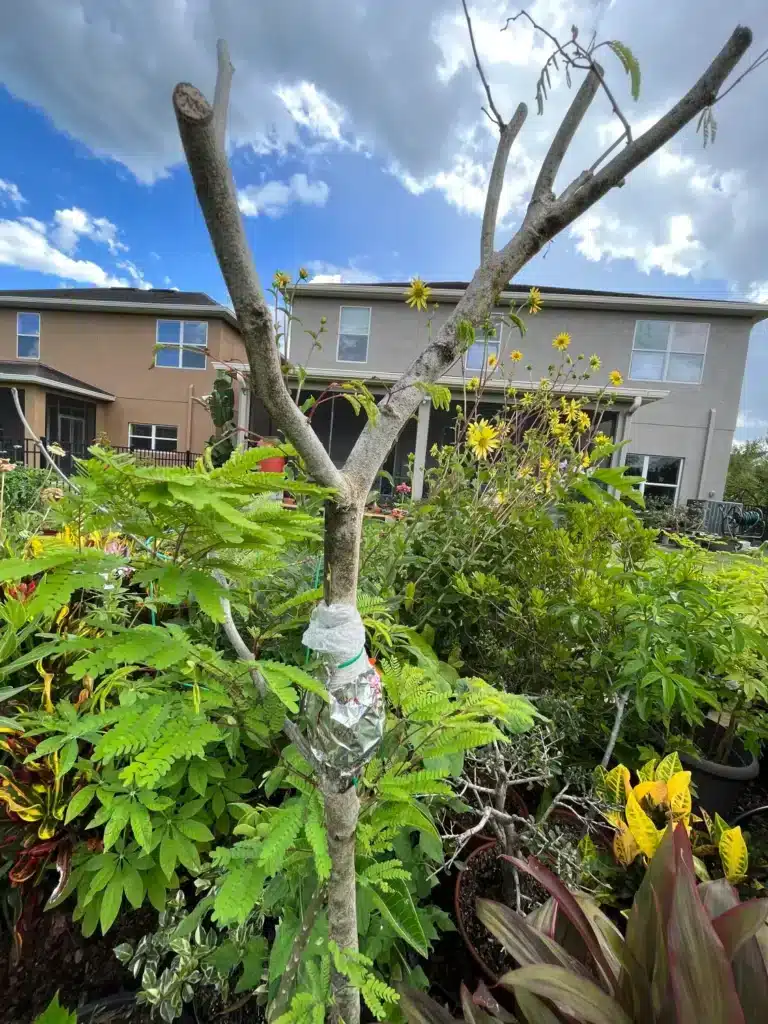
I am sure there are others that I don’t know of, so I will keep an eye out.
Leucaena leucocephala
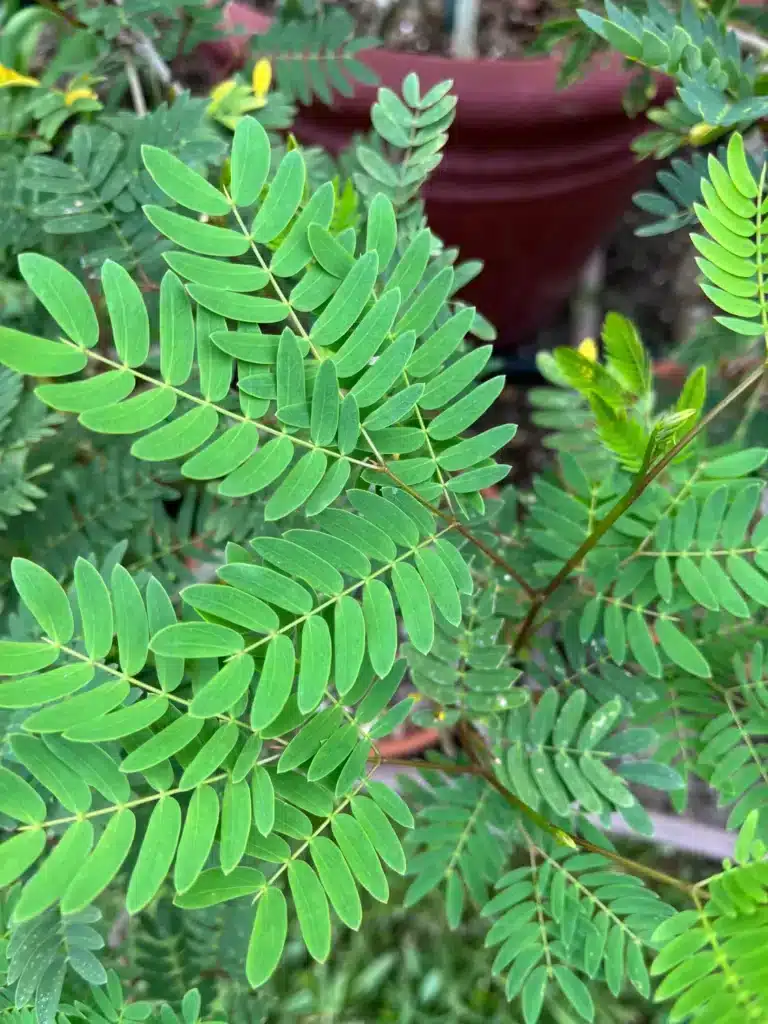
Tamarindus indica
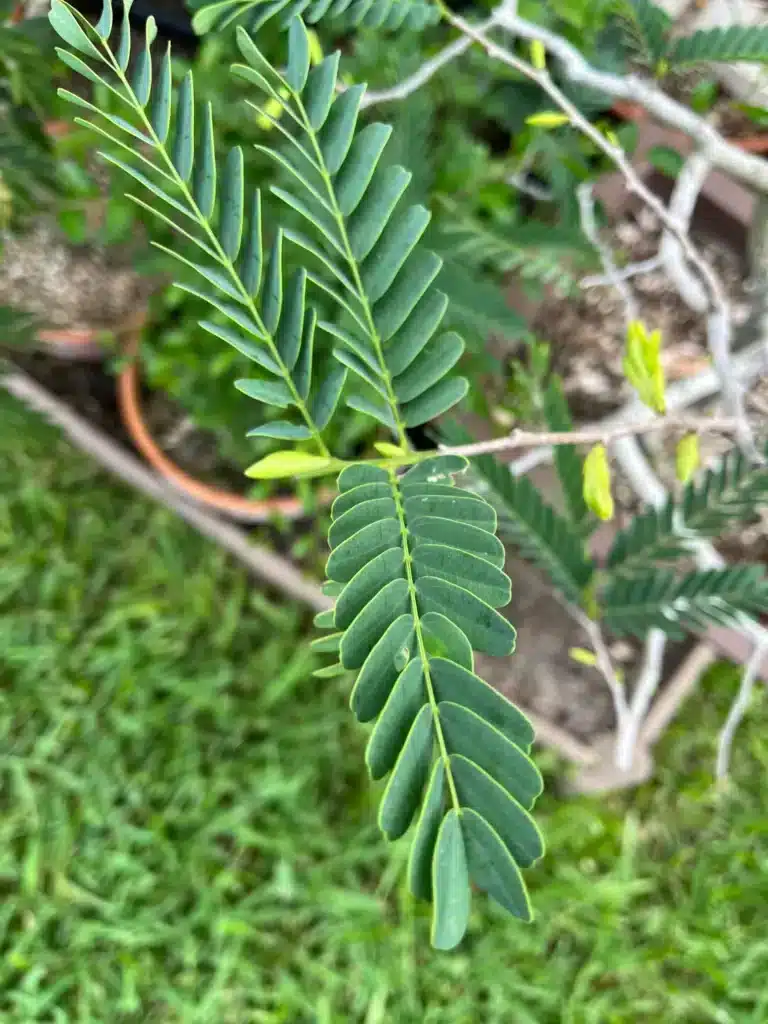
Lysiloma latisiquum
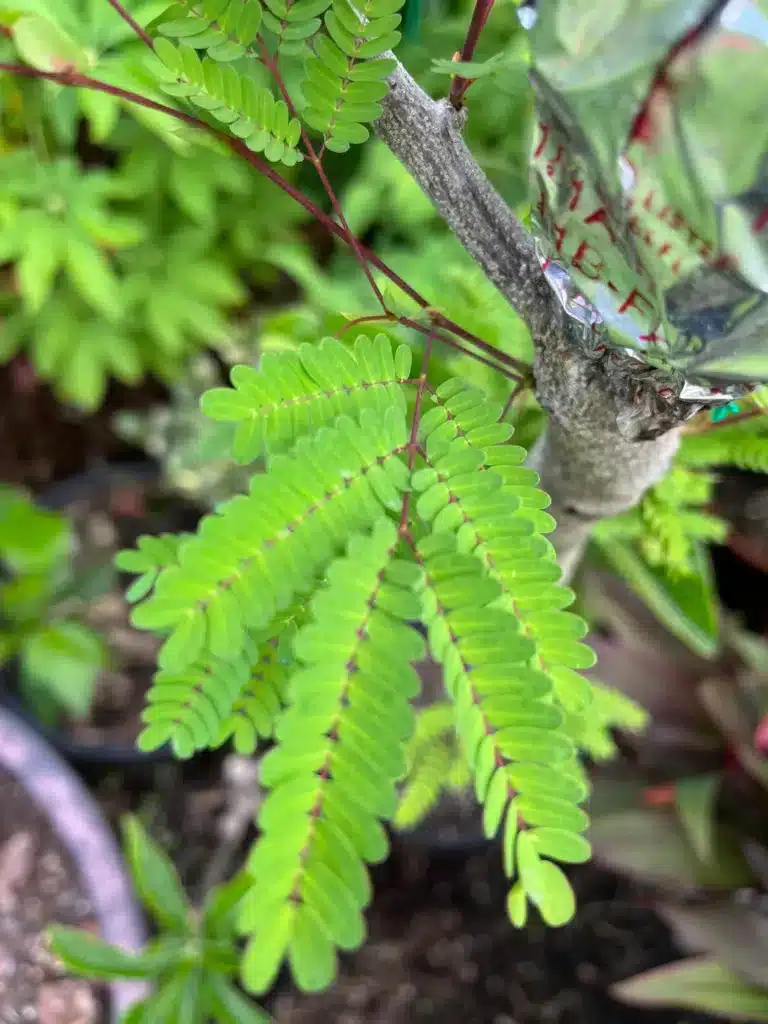
2022 BSF Scholarship Styling Contest
It was a tough competition and congrats go to all the District representatives. They were presented with Juniperus chinensis “parsonii” for the competition trees, a difficult tree to work as some of the limbs can be quick inflexible. But the first and second place winners pulled through. They are:
First place-Cayo Matteo from the Suncoast Bonsai Society.
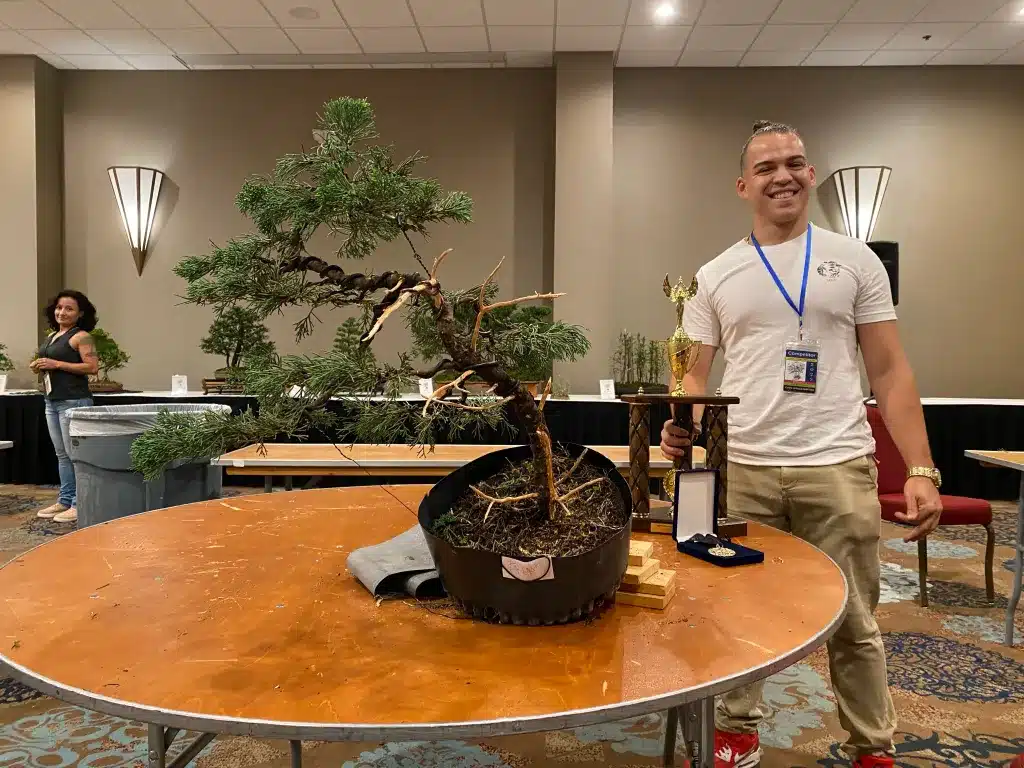
And Second place winner was Alex Mendoza from the Miami area.
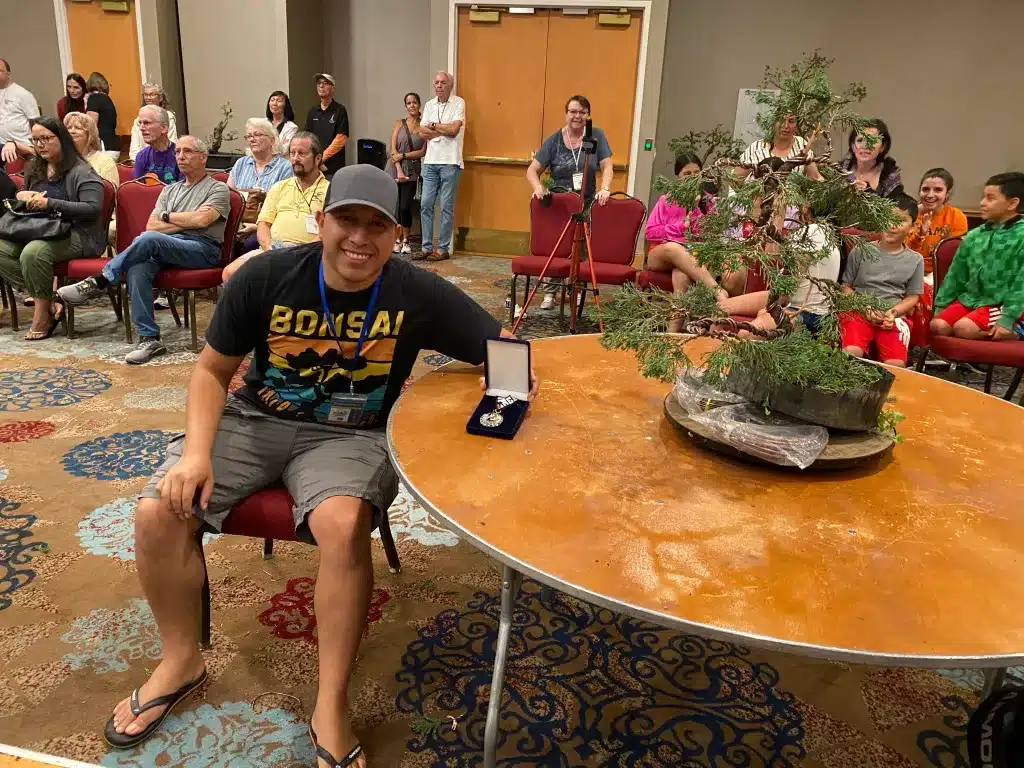
2023 BSF Convention Announcements
Convention planning has been underway since before the 2022 convention even began. We are proud to announce the headliners: Elsa Boudouri from Greece. Her website is: Bonsaicosmos.com (if the site is in Greek, find the “translate” button and change the language to your tongue of choice). We are fortunate to have secured Elsa, as she works just about every type of tree in her native Greece and Italy.
And Jose E. Rodriguez from Puerto Rico (His Facebook page ). Jose has studied with Pedro Morales, of Futago Bonsai, and is one of the preeminent tropical bonsai stylists in the USA.
There will be more in depth profiles of these two fine artists in upcoming issues of The Florida Bonsai Magazine.
The Logo Competition will begin on October 1st. The link to get to the new 2023 Convention page on our website is here The page is located in the Conventions main menu of the website. The submission form will be activated on October 1st, so start creating, and bookmark the link.
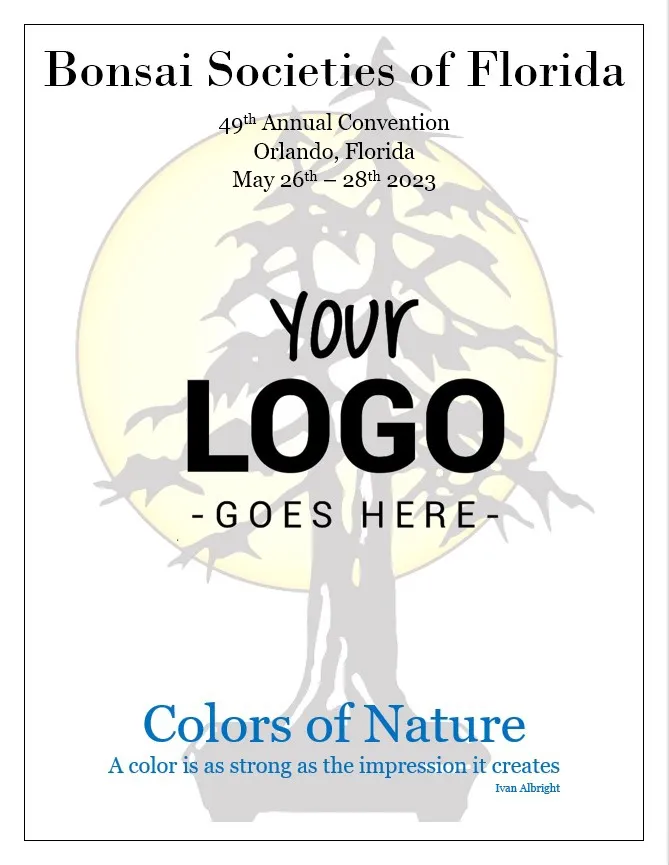
Some Selected Trees and the Award Winners from the 2022 Convention BSF Exhibit
Photos by Phil Krieg
The winners:
Best small tree, from With a Conocarpus erectus
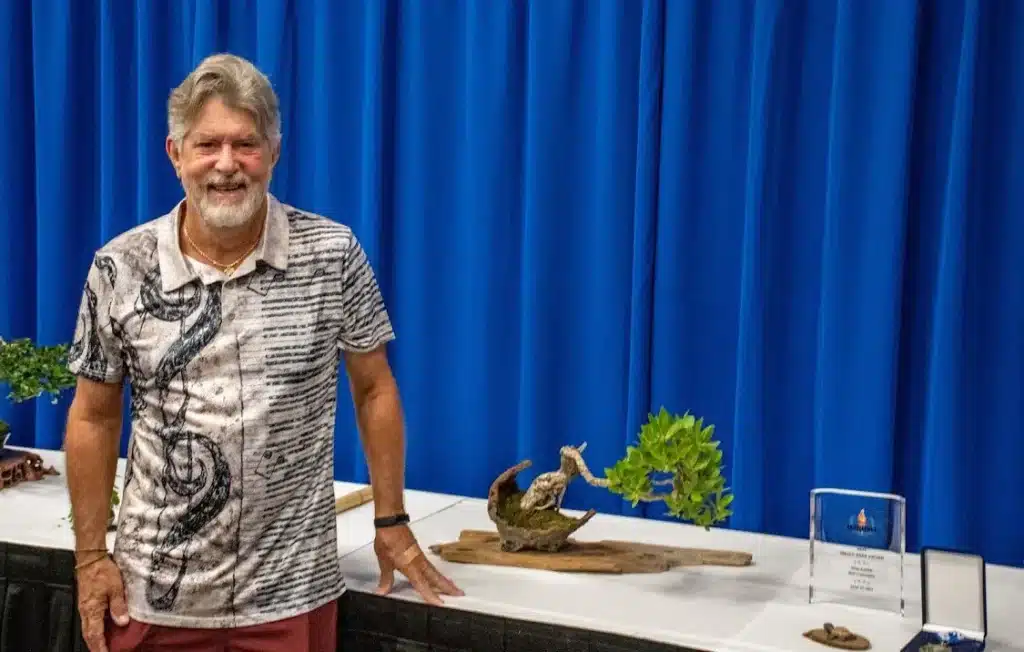
Best medium tree and best in show, from Charles Peterfy with a Juniperus chinensis “sargentii”

The Mary Madison best Florida native, from Mike Rogers with an Ulmus americana
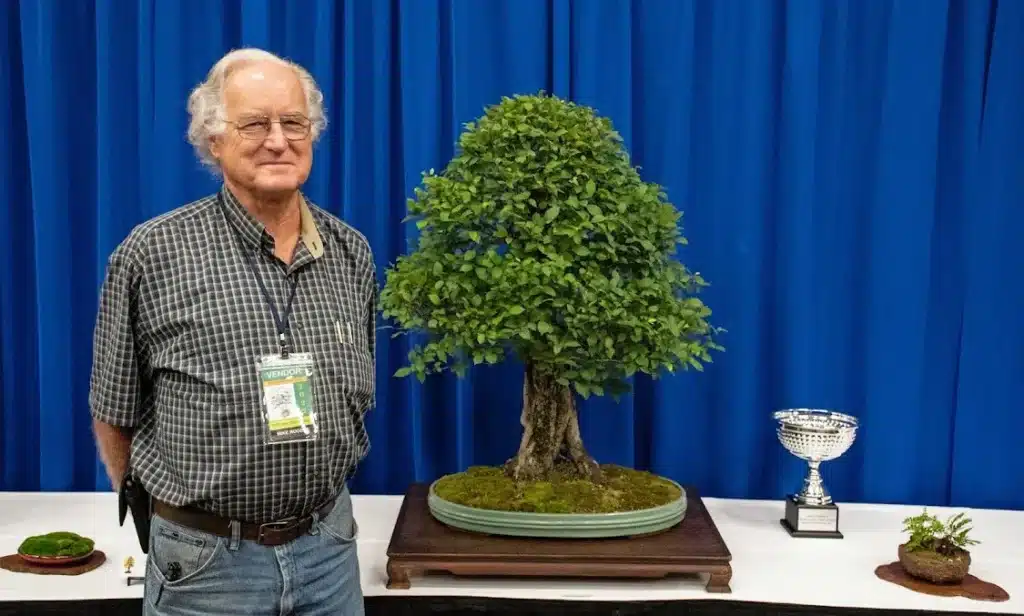
Best large tree from Paul Pikel with a Ficus microcarpa
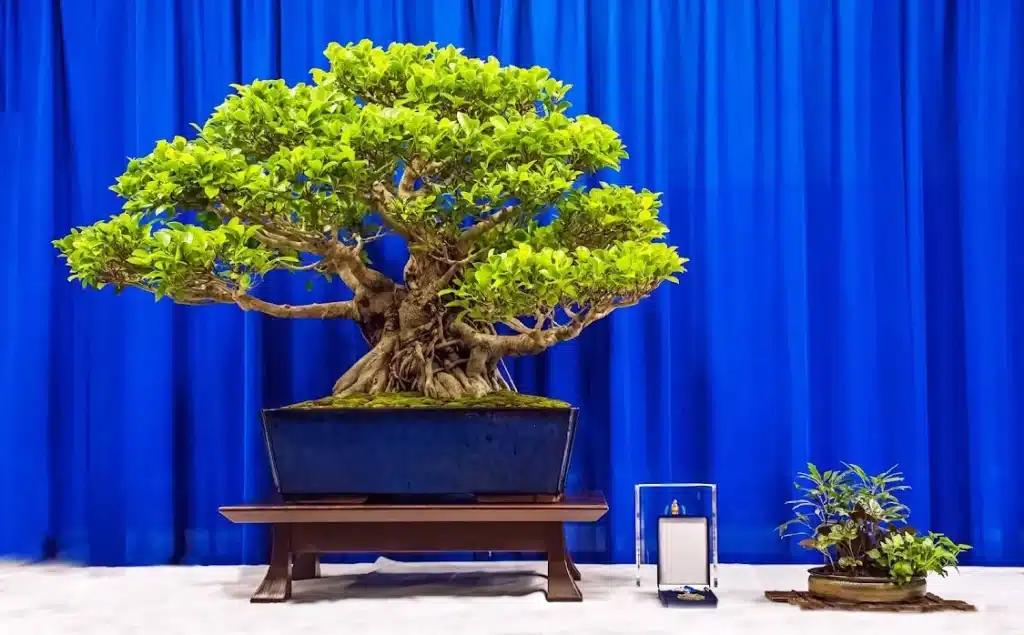
Best companion from Jeanne Cosenza with a mixed planting kusamono
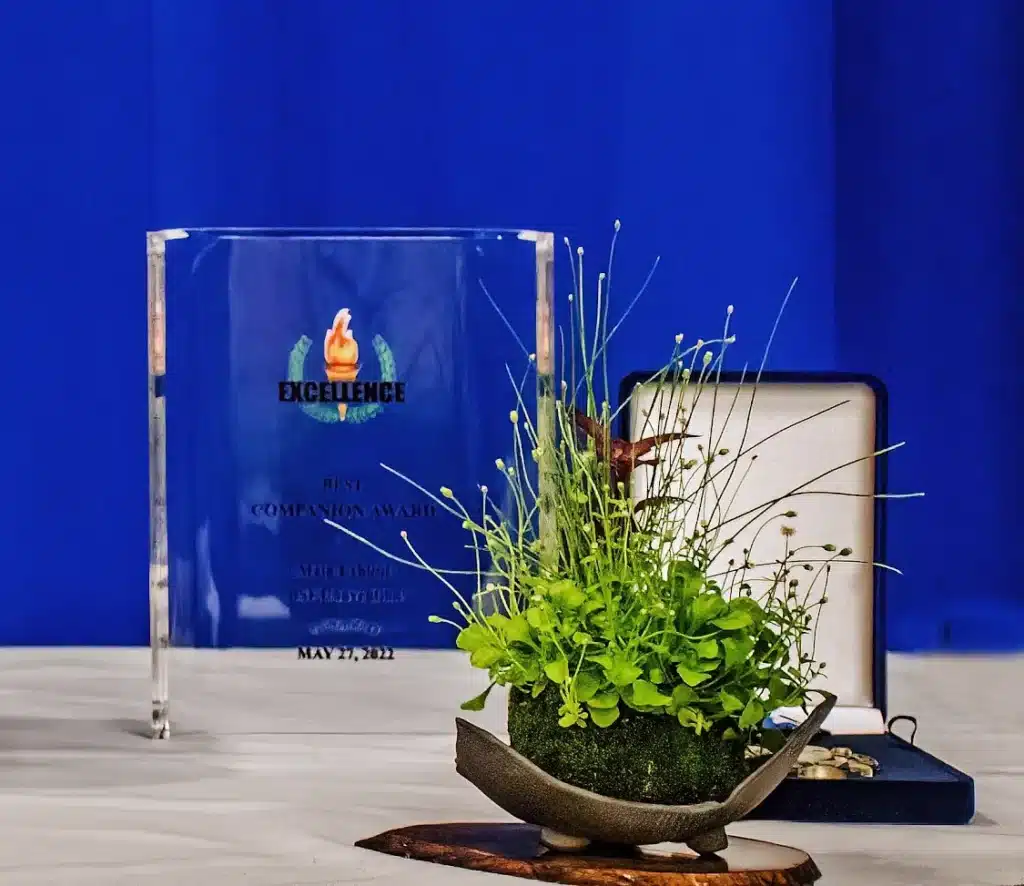
Best display from Mike and Lunetta Knowlton
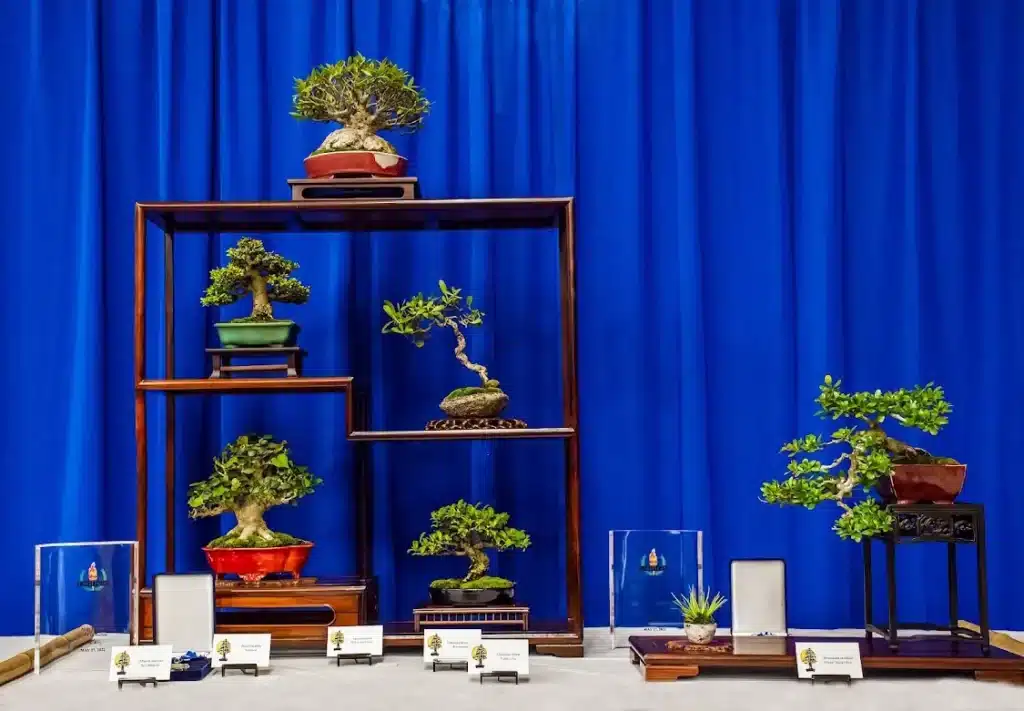
Best shohin from The Knowltons
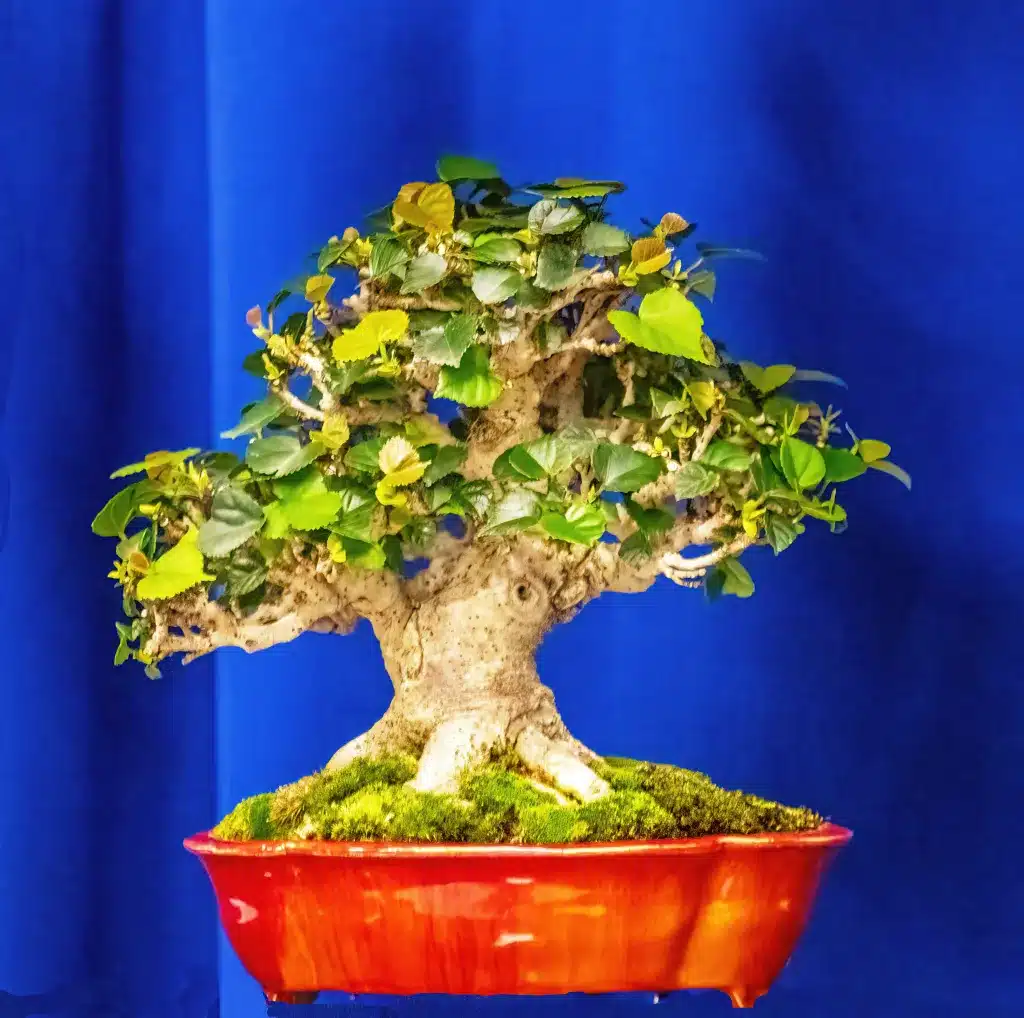
People’s Choice from Linda Gibbons with a Pinus thunbergii

President’s Award from Charles Peterfy with a Chloroleucon tortum
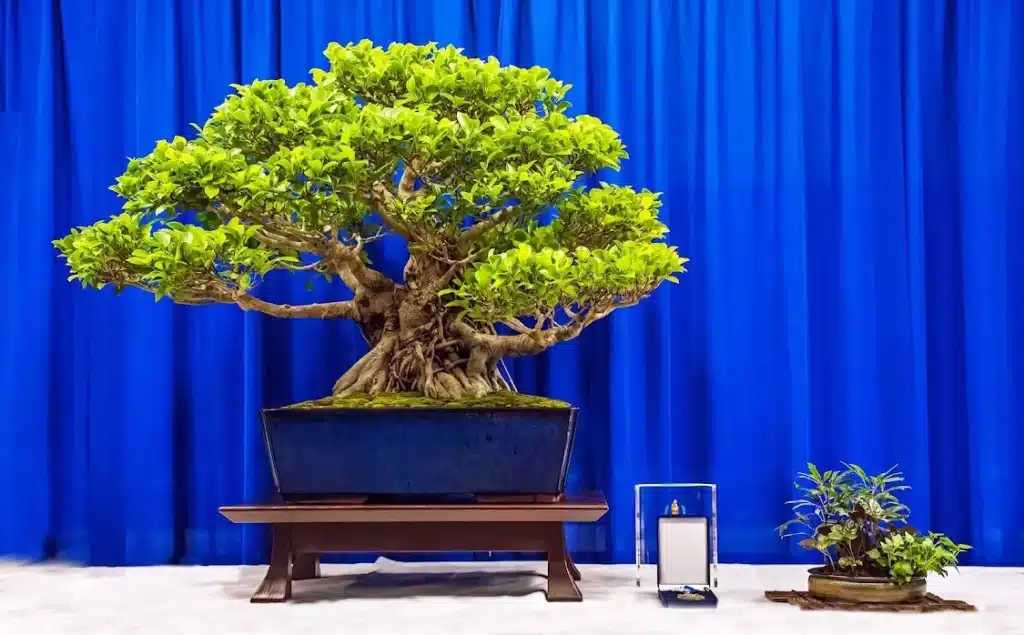
And a selection of trees from the exhibit.

And on Facebook.
From the Editor
By Adam Lavigne
First, I’d like to again thank Jorge Nazario for all his hard work not just as BSF President, but for all the roles he’s filled throughout the years. From being a grunt during his first convention, to being my VP of the Central Florida Bonsai Club, and taking the lead as Convention Volunteer coordinator, and finally as The Prez (and convention Co-chair of course). But, fear not my bonsai friends, Jorge is still on the hook. He’s Webmaster for all our sites, and Chair again of the 2023 convention.
With all that (and to scare her a bit) let’s welcome Kathrin Harris, stepping up as the BSF President. She’s moving up from the 1st Vp position and she will continue the work we’ve started in making The Bonsai Societies of Florida the premier bonsai organization in the country.
As you’ve read above, one of the major events at the conventions is the BSF Scholarship Styling Competition. This is a reminder that all you club presidents should start thinking about the club level styling contests. The finals at the convention cannot take place until you all compete, first at the clubs, then in districts events, and finally at the convention. Up for grabs is $1000 towards bonsai education for first place, then $500 for second place. Not too shabby. The monies can be used for instruction, tools, travel to a class or school. So, if you’re ready to go to the next level, bug your presidents and your district trustees, and get them to work.
As mentioned by Kathrin, BSF dues will not be going up for the 2023 calendar year, but shall remain just $15 a year. I know a guy whose Uber eats orders are twice that for a Wednesday afternoon lunch and he doesn’t blink an eye, in fact, he does that daily. We stretch those 15 dollars quite a bit.
The 2023 convention plans are underway in full force. If you are artistically inclined, make sure you come up with something and submit it for our annual logo contest (Link). We are welcoming Elsa Boudouri from Greece and Jose E. Rodriguez from Puerto Rico as this years headliners, with demos from our first and second place Scholarship Winners, Cayo Mateo and Alex Mendoza. A huge vendor area, the best trees in the state on exhibit, Club Night, raffles, auction and more. Watch this magazine, the BSF Facebook and Instagram pages, and your emails for all the updates.
Upcoming events:
The annual Multi-Club Auction and Picnic is coming up on Saturday, October 29, at F. Burton Smith Park set up times and start times on the flyer. Full details will be forthcoming on the Facebook and Instagram pages.
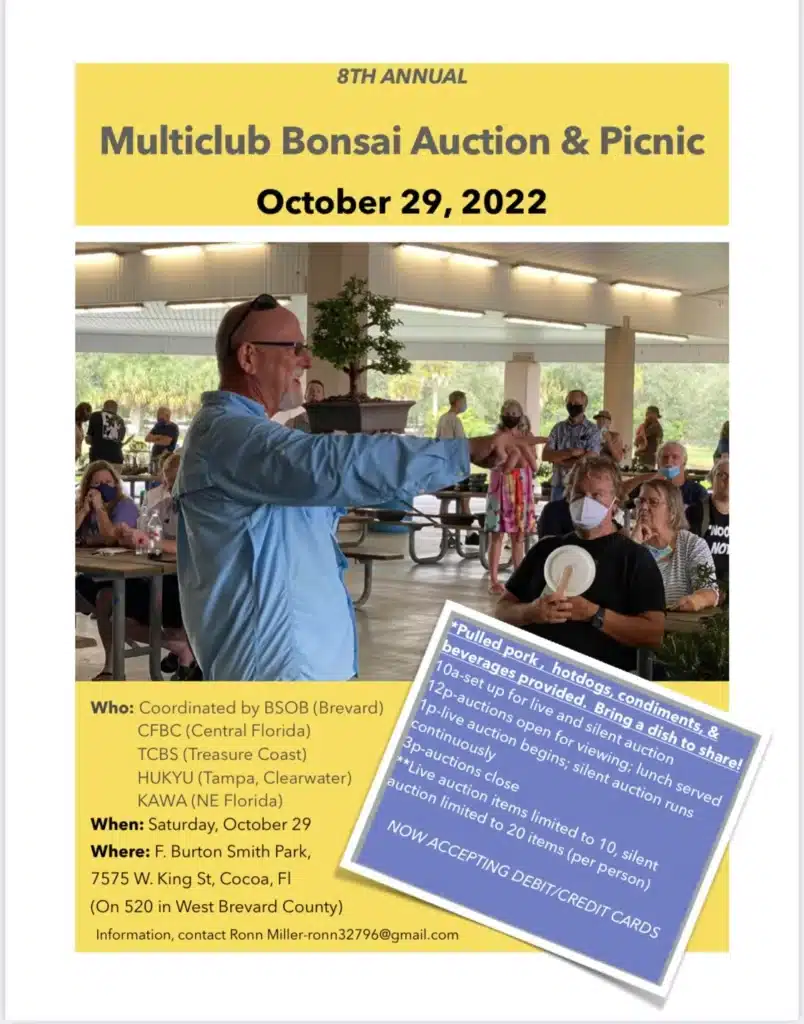
Winter Silhouette Show in Kannapolis
December 3&4 2022
North Carolina Research Campus, 150 N Research Campus Drive, Kannapolis, NC 28081
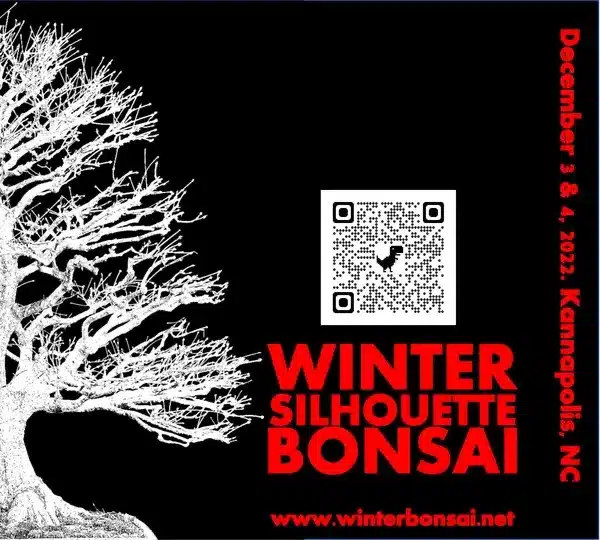
Joy of Bonsai
February 3-5 2023
Deland, Fl
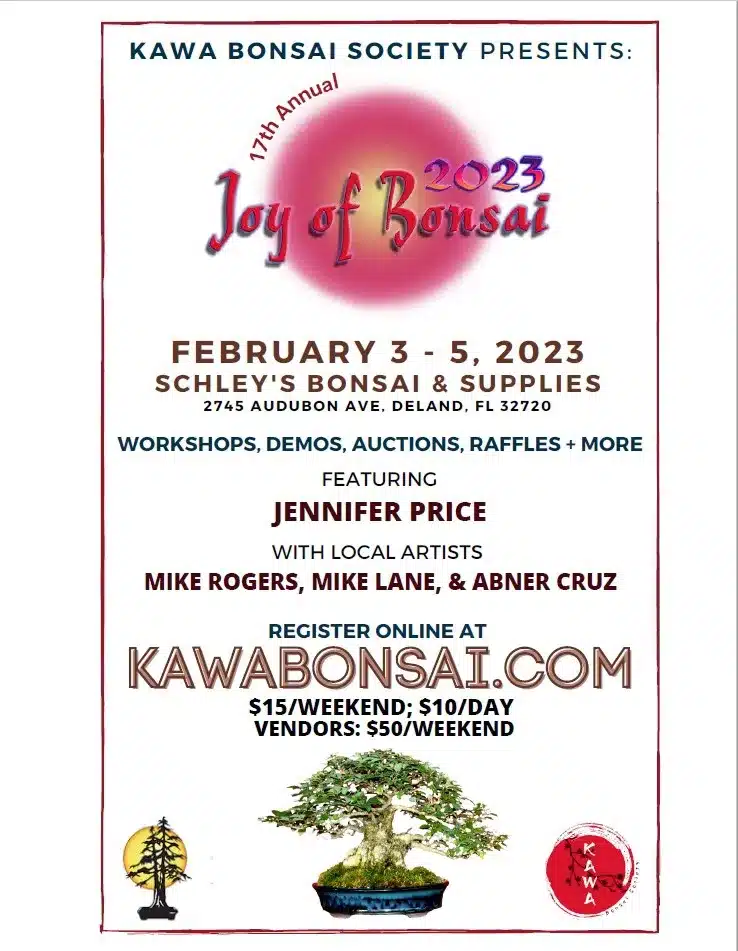
©️2022 Bonsai Societies of Florida all rights reserved unless otherwise noted


